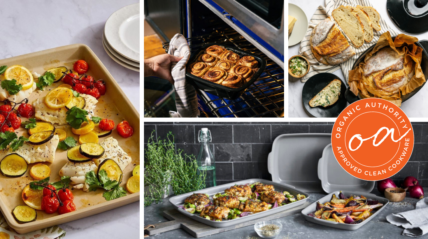
Cookware safety is a huge topic in the world of food today. People aren’t just becoming meticulous about their food choices — organic this, grass-fed that — they’re also becoming meticulous about the cookware they use.
So when was the last time you questioned what your well-used pan is secretly leaching into Thursday night’s stir-fry? And what is leaching, exactly? Spoiler alert: your pan might be serving up more than just dinner. Pots and pans made with PFAS chemicals (also known as “forever chemicals”) can introduce unwanted chemicals and substances into our food via normal wear and tear.
As the founder of Organic Authority and a culinary school graduate, I’ve spent over a decade testing virtually all of the best cookware materials available to home cooks and professionals alike. Cookware safety is no small concern — the material you choose affects not just the taste of your food, but your exposure to chemicals as well.
Let’s dive into the science behind cookware safety, compare the usual suspects hanging in your kitchen, and discover why pure ceramic options like Xtrema Pure Ceramic Cookware deserve their moment in the spotlight.
TL;DR
- Chemical leaching from traditional nonstick cookware can introduce PFAS (“forever chemicals”) and other unwanted toxins into your food
- 100% pure ceramic cookware from Xtrema offers a non-toxic alternative with zero risk of exposure to PFAS or other pesky contaminants, like heavy metals
- The naturally nonstick surface offered by pure ceramic cookware means you don’t have to sacrifice ease of use or efficiency when making the switch from traditional nonstick

What Is Leaching in Cookware?
Imagine you’ve just finished simmering a delicious tomato sauce. What you can’t see is the molecular dance happening between the acidic tomatoes and your cookware, changing the composition of your delicious sauce. That’s leaching — when chemicals, compounds, or elements transfer from your pots and pans into your food.
In my test kitchen, I’ve seen this phenomenon firsthand. After conducting hundreds of tests across different cookware materials, I’ve observed how certain pans discolor from acidic foods, impart metallic flavors, or leave measurable trace residues. In fact, a 2022 study from the University of Southern California found that a damaged nonstick pan could release up to 9,000 microplastic particles per serving1.
So is there a way to understand how and why these unwanted party crashers end up in your food? There are a several factors that influence how much leaching takes place:
- Heat levels: Higher temperatures are basically like sending out an open invitation for chemical reactions.
- Food acidity: Acidic foods, like tomatoes, break the bonds in metal and invite them to join the party — whether through trace residues or a metallic flavor.
- Cooking duration: The longer your Sunday sauce simmers, the more time there is for unwanted elements to RSVP “yes” and get in the mix.
- Cookware age and condition: Those battle scars on your favorite pan? They introduce chemicals and flaky bits of your cookware’s coating into your food.
- Cleaning methods: Furiously scrubbing a pan because you’re trying to remove a spot can damage protective surfaces — and even the best cookware materials aren’t immune.
Of course, the most important factor isn’t any of the above — it’s whether your cookware has chemicals in it in the first place. And the concerning part isn’t just one meal, it’s the risk of cumulative repeat exposure to these chemicals after hundreds of meals.
The Hidden Dangers of Leaching
Several substances in conventional cookware have scientists raising their eyebrows:
- PFAS (“forever chemicals”): Used in nonstick coatings, scientists are discovering that these compounds quite literally never go away — they persist in the environment and the human body for years. Studies have linked them to hormone disruption, immune system effects2, and certain cancers3, which is why non-toxic, PFAS-free cookware is so important.
- Heavy metals: Lead, cadmium, and nickel can leach from some cookware materials, potentially affecting the human nervous system over time4.
- Aluminum: While its health risks remain hotly debated, some research suggests aluminum may cause neurological damage with long-term exposure.
- Microplastic particles: These microscopic bits of plastic are released from a variety of types of cookware materials, from damaged PFAS and Teflon pans to plastic cutting boards and utensils. Concerningly, they’ve been linked to an increased risk of DNA damage, organ dysfunction, metabolic disorder, and even cancer5.

Fact: 99% of Americans today have detectable PFAS levels in their blood6.
A Science-Backed Comparison of Common Cookware Materials
If you’re not sure what types of cookware materials are safe to use, you’re not alone. You want cookware that’s a pleasure to use, easy to clean, and delivers great outcomes — but that doesn’t always mean it’s good for your health. Read on to understand the problem with nonstick cookware options and what alternatives to use instead.

Nonstick Coatings and Teflon Cookware
Traditional nonstick surfaces were first championed by DuPont under the name Teflon, and they revolutionized cooking in the 1960s. However, the nonstick pan’s safety was called into question shortly after, when we realized that the polytetrafluoroethylene (PTFE) and perfluorooctanoic acid (PFOA) used to create these pans came with consequences to our health and the environment.
These “forever chemicals” are the plastic straws of the cookware world — they stick around in the environment and your body long after you’re done with them. Research published in the journal Environmental Science & Technology found that PTFE-coated pans can release various fluorinated compounds when heated above 464°F (240°C)7. And the American Cancer Society notes that PFOA has been designated as a possible carcinogen, with studies linking PFAS exposure to immune system suppression, thyroid disease, and other health issues8. In other words, we have more than enough reasons to be concerned about PFAS in cookware.
Aluminum Cookware
Aluminum is one of the best conductors of heat in cookware, second only to copper. It’s also lightweight and affordable. But leaching is a possible concern with aluminum cookware, especially with certain foods.
A study in the Journal of Food Protection found that aluminum leaching increased significantly when cooking acidic foods, with tomato sauce showing aluminum levels up to 3-6 mg per serving — well above what you’d normally consume9. And while the human body can eliminate most aluminum, some research has examined connections between accumulated aluminum exposure and neurological conditions10.
Anodized aluminum provides a harder, more stable surface — but scratches can still compromise this protection.
Stainless Steel

Stainless steel is a great option that’s used in many professional kitchens. However, it is an alloy containing nickel, chromium, and sometimes molybdenum — all of which can leach in small amounts.
Research in the Journal of Agricultural and Food Chemistry found that stainless steel cookware releases nickel and chromium, particularly when cooking acidic foods11. This poses potential concerns for anyone with nickel sensitivities — about 10% of the population.
Higher-quality stainless steel (18/10 or 18/8 grades) tends to be more stable, but even the best stainless steel isn’t completely leach-proof.
Cast Iron
Cast iron has enjoyed a hipster renaissance as of late. What’s old is cool again, and cast iron has proven to be a timeless kitchen staple. While these pots and pans ensure there are no synthetic chemicals near your food, they can leach iron — which can be either a feature or a bug, depending on your health needs.
A study in the Journal of the American Dietetic Association found that acidic foods cooked in cast iron can increase iron content by up to 20 times12. While that might help those with an iron deficiency, it could be problematic for people with hemochromatosis or iron metabolism disorders.
Additionally, poorly seasoned cast iron may leach more aggressively and impart metallic flavors into your food because of the direct contact with metal. Proper seasoning does create a polymerized oil layer that can reduce leaching and create a nonstick-like effect.
Copper Cookware

Copper provides exceptional heat control, but it poses serious toxicity concerns when used unlined. The FDA advises that copper cookware be lined with interior linings of tin or stainless steel to prevent leaching13.
The downside is that these linings can wear over time, potentially exposing the copper underneath. Small amounts of copper may still migrate into your food if the lining has any damage.
Pure Ceramic Cookware: The Xtrema Difference
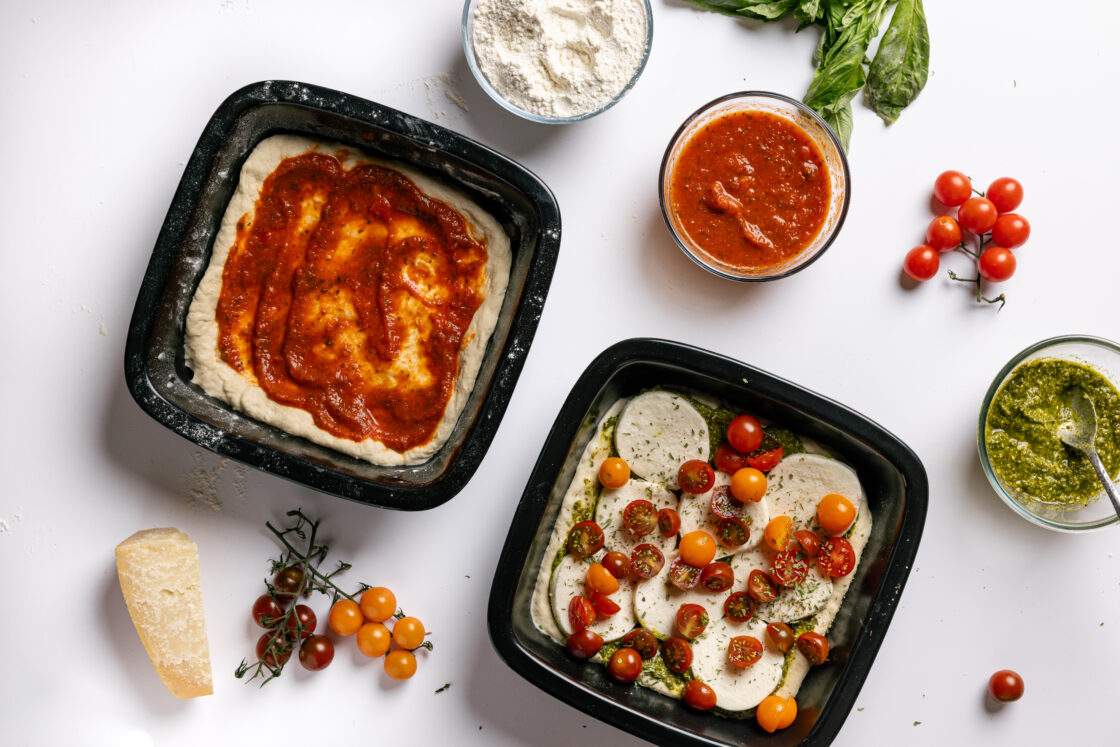
Amidst these varying concerns, pure ceramic cookware like Xtrema stands out by addressing the fundamental issues that cause leaching in the first place. So, let’s answer the question once and for all — is ceramic cookware safe?
While conventional nonstick cookware uses synthetic PFAS chemicals to create a coating, Xtrema achieves its food-release properties through a naturally smooth, non-porous surface.
| Property | Pure Ceramic (Xtrema) | Ceramic-Coated | Traditional Nonstick | Copper | Cast Iron | Stainless Steel | Aluminum |
| Composition | 100% ceramic | Metal base + ceramic coat | Metal + PTFE (Teflon) | Pure or lined copper | Iron + natural seasoning | Iron, chromium, nickel | Pure or anodized aluminum |
| Max Temperature | 2500°F (1371°C) | 600-800°F (315-427°C) | 500°F (260°C) | ~450°F (unlined), ~600°F (lined) | ~600°F (316°C) | 500-600°F | ~450°F (232°C) |
| Scratch Resistance | High | Moderate | Low | Low – moderate (lined scratches easily) | High | High | Low – moderate |
| Longevity | 10+ years (with care) | 1-3 years | 1-5 years | Decades (if lined) | Lifetime (with care) | Lifetime | 2-5 years (depends on use) |
| Chemical Leaching | None | Minimal | Potential at high temps | High if unlined | Iron (beneficial or not) | Trace nickel/chromium | High when uncoated or scratched |
| Ease of Cleaning | Moderate | Easy | Very easy | High maintenance | Requires seasoning | Moderate | Easy if anodized |
| Weight | Moderate | Lightweight – Moderate | Lightweight | Heavy | Heavy | Moderate | Light |
| Price Range | $$$ | $$ | $-$$ | $$$ | $$-$$$ | $$-$$$ | $-$$ |
| Reactivity with Acids | Non-reactive | Usually non-reactive | Can degrade with acids | Highly reactive if unlined | Can react without seasoning | Slight with prolonged exposure | High unless anodized, coated, or cladded |
| Oven/Dishwasher-Safe | Yes (check product) | Sometimes oven-safe | Often not oven-safe | Often not dishwasher-safe | Oven-safe, hand washing best | Oven and dishwasher-safe | Sometimes dishwasher-safe |
100% Pure Ceramic Composition Explained
Unlike ceramic-coated nonstick cookware, Xtrema cookware is 100% ceramic throughout. We’re talking pure ceramic from core to surface, no identity crisis here. This all-ceramic construction entirely eliminates the metal components that are the primary sources of leaching in most cookware.
No “forever chemicals” or heavy metals can leach into your food, because they simply aren’t there.
While conventional nonstick cookware uses synthetic PFAS chemicals to create a coating, Xtrema achieves its food-release properties through a naturally smooth, non-porous surface. This means no “forever chemicals” or heavy metals can leach into your food, because they simply aren’t there.
Ceramic materials primarily consist of inorganic compounds, which makes them stable and resistant to the chemical reactions that cause leaching. They also don’t offgas or produce harmful fumes when heated (unlike PFAS nonstick cookware!).
A Manufacturing Process that Eliminates Toxic Materials

Pure ceramic cookware is composed of naturally occurring minerals and inorganic compounds, which are transformed through a high-temperature firing process. This process avoids introducing PFAS, PTFE, and other fluorinated compounds, as well as heavy metals like lead and cadmium.
Overall, the triple-fired manufacturing process results in an extremely stable cooking surface that’s all natural and resists breaking down — which is why pure ceramic is one of the best cookware materials. And while many cookware materials become more reactive at high temperatures, Xtrema can withstand temperatures up to 2500°F.
To put that into perspective, today’s traditional PTFE-coated nonstick cookware starts to deteriorate and may release toxic fumes starting at around 500°F. Anything above that, and things get worse — the coating significantly degrades, and at 650°F it can release compounds that cause “polymer fume fever.14”
Save 15% with our exclusive code: OA15
Third-Party Testing and Certification
Xtrema stands behind its safety claims with rigorous independent third-party testing by SGS, the world’s leading testing, verification, inspection, and certification company. SGS offers a much better test than an at-home XRF and lead swab test, which is less effective and doesn’t measure real leaching. Their cookware also undergoes testing for heavy metals like lead, cadmium, and cobalt, and they’re California Prop 65 and LFGB (the European Union’s standards) compliant.

These tests confirm that the cookware maintains its integrity even under demanding cooking conditions. You could say that Xtrema’s pure ceramic has officially passed the test as one of the best cookware materials out there. We at Organic Authority agree — Xtrema Cookware has met all of our standards for clean cookware and has earned the OA Approved Seal.
Why I Love Cooking with Pure Ceramic Cookware
Cooking with Xtrema ceramic pots and pans is like getting back to your grandmother’s roots of slow cooking. It gently forces you to slow down in the kitchen and savor the experience. Pure ceramic does need some special attention, but I find that it keeps me in the moment while cooking.
Xtrema’s Naturally Nonstick Surface
I was pleasantly surprised to find out how easy it was to achieve a naturally nonstick surface with Xtrema’s pure ceramic cookware. Start by preheating your pan over low heat, then add your oil and heat it through. Once your oil is hot (look for the shimmer which happens right before it starts to smoke), add your food and enjoy the benefits of chemical-free nonstick.
I love cooking egg dishes in my Xtrema pans — particularly over easy and over medium eggs. The ceramic helps them come out like slow-cooked, oven-baked eggs!
A few other recipes I love making with Xtrema are Shakshuka (fresh eggs cooked in a tangy tomato sauce and topped with feta and herbs), frittatas (try this mushroom zucchini and goat cheese frittata), and oven baked dips (this vegan baked artichoke dip is a favorite in my house). Their naturally nonstick surface also makes them a great fit for delicate fish dishes like pan seared wild salmon.
Save 15% with our exclusive code: OA15
The Versatility of Pure Ceramic

Because Xtrema cookware can handle high temperatures (up to 2500 degrees Fahrenheit!) without the possibility of leaching or degraded coatings, you don’t have to worry about limiting yourself in the kitchen. This freedom makes these Xtrema ceramic pots and pans versatile superstars, ready for anything from slow-cooked soups and stews to high-heat grilling and searing.
Plus, if you love cooking with cast iron but are tired of the weight of it, Xtrema is a great alternative. Pure ceramic cooks very similarly to cast iron — low and slow — and has ah-mazing heat retention, but it has the added benefit of being much easier to maneuver around the kitchen. And it doesn’t require seasoning! The only thing to note when it comes to versatility is that Xtrema pure ceramic cookware is not induction-compatible, so you’ll need an induction disk to use it on certain stovetops.
I’ve tested a lot of Xtrema products, from signature skillets to their Dutch oven and air fryer accessory set. Here are some of my stand-out favorites.
Our Favorite Xtrema Picks:

Traditions Sauté Pan with lid
This 10” sauté pan with lid is a favorite for large family gatherings. With its flat wide cooking surface and deep walls, it’s ideal for cooking large pasta meals, sauces, and one dish meals.
Not only is this pan a great example of PFAS-free cookware, it’s also microwave, oven, and grill-safe (up to 2,500°F). There’s no coating that can flake or leach, and it’s thermal shock resistant from fridge to stovetop.
Try your favorite one-pot dishes like this Jambalaya recipe or this classic brunch Dutch Baby pancake recipe in this sauté pan, too — I love the rustic feel that pure ceramic cookware gives to meals.
Community Reviews and Expert Recommendations
“I love this pan! Chemical-free nonstick, even heating, and super easy to clean. This is my second pan. I had my first one for almost 10 years. It dropped to the floor and broke. Couldn’t imagine cooking life without one and replaced it immediately.” — Cathleen M., verified customer
“These pans are amazing. Extremely satisfied. Not only are they non-toxic but they are the best nonstick and easy to clean pan I’ve ever owned. You can literally wipe them clean.” — Joseph O., verified customer

Specs:
10-inch saute pan with lid
- 5 lb weight
- 10.5 in. wide x 19.5 in. long x 2.8 in. high
- 3.5 qt capacity
Price: $198.04 at time of publish
Save 15% with our exclusive code: OA15
The Signature Skillet
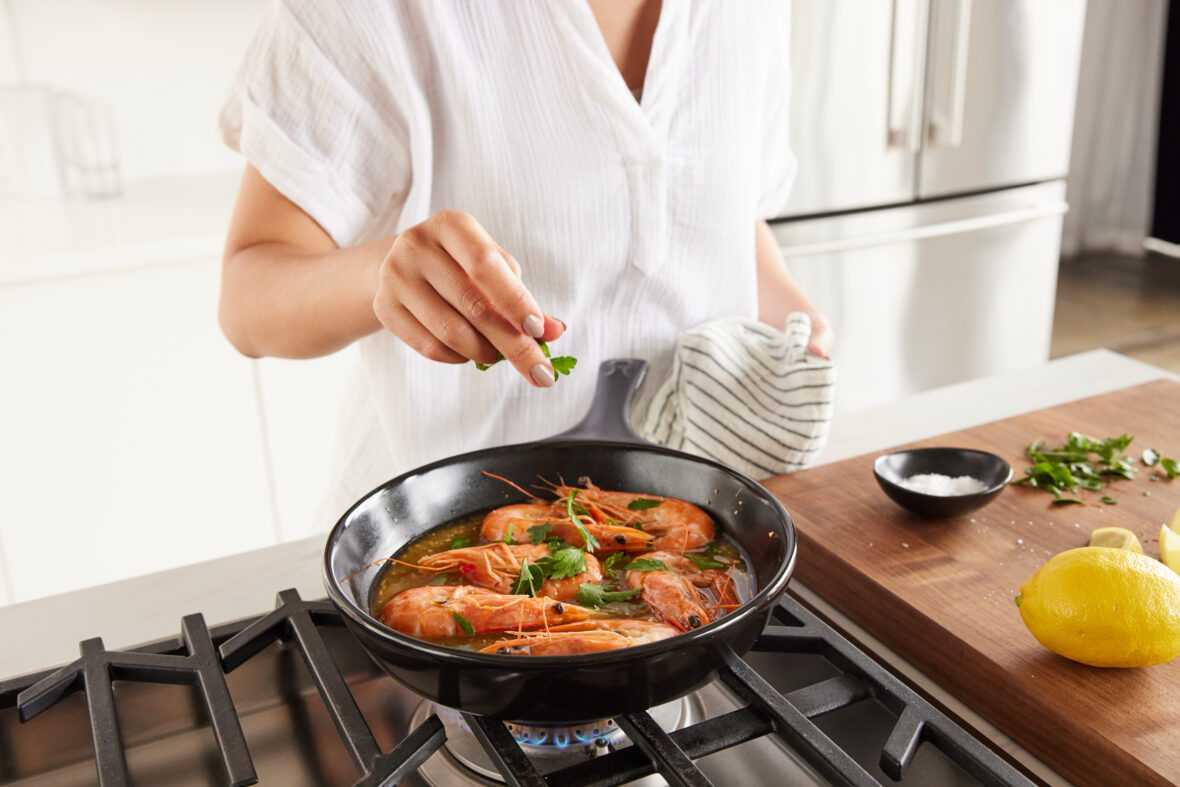
This is about to be your go-to everyday ceramic skillet in your new PFAS-free cookware collection. I use it for everything from cooking my eggs and fish, to baking and serving warm dips.
You can even use the skillet on the grill to sear up your favorite proteins, like this whole grilled chipotle chicken, or grill your favorite veggies, like these grilled carrots with honey and dill. Just remember to heat the skillet up slowly and take your time.
Community Reviews and Expert Recommendations
“I purchased this skillet for my husband who does breakfast duty. He loves this skillet, the way it cooks a variety of food and the ease with which it is cleaned. We both like the light weight and appearance to this skillet. Bravo to Xtrema for another great product!!” — Jeannine G., verified customer
“Can not express enough how much I love these pans! Threw out old toxic pots and pans and looking forward to replacing them all with Xtrema!” — Charlotte S., verified customer

Price:
7-inch skillet: $99.99
9-inch skillet: $149.99
11-inch skillet: $199.99
Save 15% with our exclusive code: OA15
The Pure Ceramic Dutch Oven

I love Dutch ovens. I think every kitchen needs one for low and slow soups and stews. They’re honestly one of my favorite cooking tools, and the fact that this is made of one of the best cookware materials makes it even better. Xtrema’s Dutch Oven comes in two shapes to choose from — their 10-quart Round Dutch Oven or the Classic Oval Dutch Oven. I’ve tested both and love them equally (you can read my full review of the Classic Oval Dutch Oven here) — they’re both stand-outs in my growing collection of Xtrema ceramic cookware.
Try these slow-cooked recipes like lasagna soup, chicken tortilla soup, your favorite bone broth recipe, or this white bean stew recipe with parmesan, greens, and anchovies. Their Dutch oven is also ideal for baking your favorite bread on a slow Sunday morning or roasting your favorite whole chicken and veggies in the oven. It’s even safe to use on the grill, or over an open flame.
Community Reviews and Expert Recommendations
“Best Dutch oven. Lighter than other popular brands and non-toxic. I love the 2.5 qt for making fragrant rice.” — Yung, verified customer
“I just purchased the oval Dutch oven last month because it’s the perfect size for cooking our turkey breast for Thanksgiving, and also making soups in the winter time. I have our Christmas turkey waiting for it. I have many pieces of this cookware, some I’ve had for many years and I love it all. It’s easy cleaning and gives me peace of mind knowing that I’m cooking in something that’s totally non-toxic.” — Tessa F., verified customer

Specs:
- 7.5 qt. capacity
- 10 in. wide x 16.5 in. long x 6.3 in. high
- 12 lb weight
Price: $314.99 at time of publish
- 10 qt. capacity
- 13 in. wide x 16 in. long x 9 in. high
- 12.4 lb weight
Price: $344.69 at time of publish
Save 15% with our exclusive code: OA15
Why Pure Ceramic Cookware Is Best
Cleaning and Maintenance
The non-porous surface on Xtrema’s pure ceramic cookware makes it easy to clean without harsh chemicals. This smooth surface also prevents the absorption of food particles and makes it resistant to bacteria growth, which makes it more hygienic, too. It’s also super easy to clean with some mild soap and water. Avoid using metal scrubbers or abrasive cleaners.
For stubborn, stuck-on stains (they do happen!), use the baking soda trick. Add some baking soda and water to the pan and place over low heat for 5-10 minutes. Using a wooden spoon, run it across the stuck-on food to lift and clean. Finish cleaning with warm, soapy water.
Ceramic-Coated Cookware vs. Pure Ceramic Cookware
It’s important to note that ceramic-coated cookware is not the same as pure ceramic cookware.
Ceramic-coated cookware has a metal base, usually stainless steel or aluminum or a combination of both, with a ceramic coating that’s adhered to it. Over time, the ceramic coatings can wear off, potentially exposing the metals underneath.. The durability and safety of the ceramic-coated cookware largely depends on the quality of the coating and the adherence to the base. If you’re lucky, you’ll get three to five years out of your ceramic-coated cookware.
On the other hand, pure ceramic like Xtrema cookware doesn’t rely on a coating, so you never have to worry about exposure to heavy metals. And unlike ceramic-coated cookware, if taken care of properly, pure ceramic can last a lifetime.
Taking Cookware Safety Into Your Own Hands
The science is clear: what we cook matters, but so do the tools we use to cook. Different cookware materials present varying levels of risk through leaching, with some materials raising more significant concerns than others. As consumers become more aware of potential sources of exposures in their daily lives, the cookware industry is responding with increased transparency and improved options.
Pure ceramic cookware like Xtrema represents a fundamental shift in approach. Rather than trying to minimize leaching from potentially reactive materials, it eliminates the concern at the source by only using stable, non-reactive materials.
By understanding the science behind leaching and the available alternatives, you can make informed choices that support your family’s health while still maintaining culinary excellence. Xtrema’s pure ceramic means the only secret ingredients in your food are from your nonna’s treasured family recipe — not chemicals from your pans.
Sources:
- https://www.sciencedirect.com/science/article/abs/pii/S004896972205392X
- https://pmc.ncbi.nlm.nih.gov/articles/PMC11081924/
- https://dceg.cancer.gov/research/what-we-study/pfas
- https://pmc.ncbi.nlm.nih.gov/articles/PMC1474439/
- https://www.sciencedirect.com/science/article/abs/pii/S0024320524005277
- https://www.ewg.org/what-are-pfas-chemicals
- https://www.researchgate.net/publication/336155352_Impact_of_household_cooking_on_release_of_fluorinated_compounds_PFOA_and_PFOS_from_Tefal_coated_cookware_to_foods
- https://www.cancer.org/cancer/risk-prevention/chemicals/teflon-and-perfluorooctanoic-acid-pfoa.html
- https://www.researchgate.net/publication/227779839_Leaching_of_aluminium_from_utensils_during_cooking_of_food
- https://pmc.ncbi.nlm.nih.gov/articles/PMC6040147/
- https://pmc.ncbi.nlm.nih.gov/articles/PMC4284091/
- https://pmc.ncbi.nlm.nih.gov/articles/PMC8266402/
- https://www.mountsinai.org/health-library/nutrition/cooking-utensils-and-nutrition
- https://www.ncbi.nlm.nih.gov/books/NBK594276/


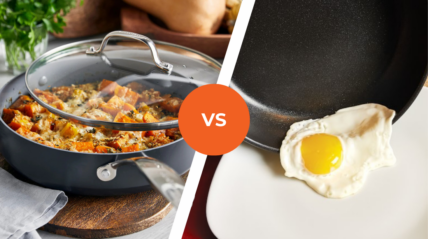
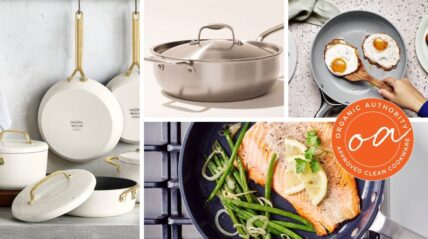
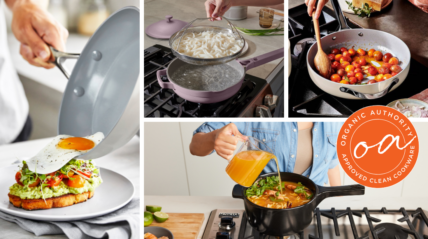
![8 Best Non-Toxic Cookware of 2025 [Chef Reviewed, Rated & Ranked]](https://www.organicauthority.com/wp-content/uploads/2024/09/Hero-Image-1-428x239.png)
